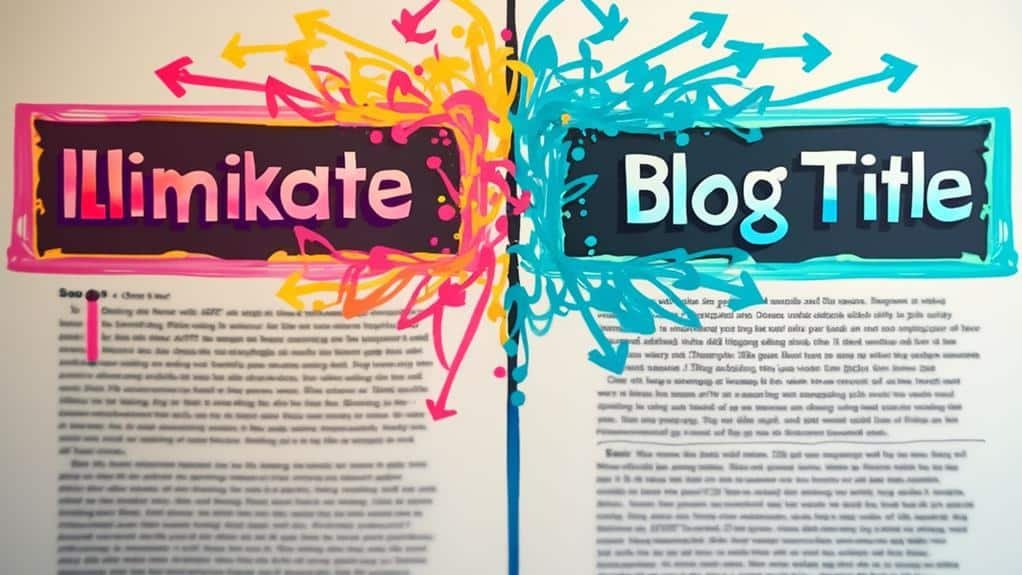To create an irresistible SEO blog title, know your audience and use relevant keywords they're searching for. Keep it concise at around 60 characters, and incorporate power words to pack an emotional punch. Grab attention with numbers, especially at the beginning of the title. Optimize for search engines with a keyword-rich headline, while still enticing clicks. A/B test different titles to see which version performs best based on key metrics. By focusing on these essential elements, you'll craft blog titles that skyrocket your search rankings and captivate readers. Explore to uncover more secrets of standout SEO titles.
Key Takeaways
- Craft compelling titles using power words to capture reader attention and drive engagement.
- Incorporate numbers in titles to provide specificity and set clear expectations for readers.
- Optimize titles for search engines by focusing on relevant keywords and keeping length between 50-60 characters.
- Evoke emotions in titles to create a lasting impression and encourage readers to click through.
- Continuously A/B test title variations to refine and optimize based on data-driven insights.
Know Your Audience
Identifying your target audience is a critical first step in creating content that resonates and drives results.
To do this effectively, you need to segment your audience based on key characteristics like demographics, psychographics, and behavior. This process, known as audience segmentation, allows you to tailor your content to specific groups within your broader target market.
Once you've identified these segments, develop detailed user personas that represent each group's goals, challenges, and preferences.
These personas will guide your content creation, ensuring that every piece speaks directly to your audience's needs and desires.
Research Relevant Keywords

Once you've identified your target audience, it's time to engage in keyword research. Conduct a thorough keyword analysis to uncover the terms and phrases your audience is using when searching for content related to your topic.
Delve into competition research to see which keywords your rivals are targeting and how they're incorporating them into their content. You'll want to focus on keywords that have a good search volume but aren't overly competitive.
Look for long-tail keywords that are more specific and easier to rank for. As you compile your list of target keywords, consider how you can naturally weave them into your content to boost your SEO efforts without compromising readability.
Keep It Concise

While incorporating relevant keywords is important, you'll want to keep your blog title concise. Aim for a title length of around 60 characters, as this guarantees it displays fully in search results and is easily digestible for readers.
A concise title also:
- Grabs the audience's attention quickly
- Improves click-through rates and audience engagement
- Conveys the main point of your article effectively
- Avoids overwhelming readers with too much information
- Aligns with the modern preference for quick, snappy content
When crafting your title, focus on the core message and most compelling aspects of your blog post. Trim any unnecessary words or phrases that don't add value.
A shorter, punchier title will help you attract and retain readers in today's fast-paced digital landscape.
Use Power Words

Power words are a potent tool for elevating your blog title's impact. By strategically employing powerful adjectives and impactful verbs, you can capture your audience's attention and entice them to click through. Consider the difference between a bland title and one infused with power words:
| Without Power Words | With Power Words |
|---|---|
| 5 Tips for Gardening | 5 Genius Hacks to Cultivate a Thriving Garden |
| How to Save Money | Discover 10 Savvy Strategies to Boost Your Savings |
| The Benefits of Yoga | Unleash the Transformative Power of Yoga for Mind and Body |
Leverage the persuasive might of power words to craft irresistible titles that command attention, spark curiosity, and drive engagement. Choose each word intentionally, ensuring your titles pack a punch and leave a lasting impression.
Incorporate Numbers

Incorporating numbers in your blog titles is a surefire way to grab readers' attention and provide them with a clear expectation of what they'll gain from your content.
Numbers make your titles more specific, actionable, and enticing. They help structure your headline for ideal title length and impact.
When crafting numbered titles, keep these tips in mind:
- Choose numbers that are realistic and achievable
- Use digits instead of spelling out numbers
- Place the number at the beginning of the title
- Select odd numbers for more engagement
- Keep the title length concise yet descriptive
Leveraging the power of numbers in your blog titles will make them more compelling, clickable, and shareable.
Evoke Emotions

Evoking emotions in your blog titles can be a powerful way to grab readers' attention and entice them to click through to your content.
Harness powerful words that resonate with your target audience and stir their feelings.
Spark curiosity and amazement by crafting titles that leave readers wanting to know more about the topic you're presenting.
Harness Powerful Words
Words are the lifeblood of your blog title, flowing through it and giving it importance. Harness their persuasive power to make an emotional impact on readers.
Choose words that:
- Evoke strong feelings
- Paint vivid mental pictures
- Resonate with your target audience
- Compel them to click through
- Align with your content's key message
Powerful, emotive language grabs attention and leaves a lasting impression. Weave in sensory details, action verbs, and persuasive phrases.
Craft titles that make bold promises, spark curiosity, or challenge assumptions. The right words, strategically chosen, have the ability to influence and inspire.
Spend time thoughtfully selecting each one to maximize the emotional impact and draw readers in. Words are your most potent tool for crafting irresistible, click-worthy titles.
Spark Curiosity, Amazement
When you pique readers' curiosity and inspire a sense of awe, you've harnessed one of the most potent attention-grabbing strategies for blog titles.
Leverage the curiosity gap by crafting titles that tease just enough information to make readers enthusiastic to click through and learn more. Incorporate a surprise element by revealing an unexpected twist, a little-known fact, or a thought-provoking question.
Titles like "The Shocking Truth About [Keyword]" or "You Won't Believe What Happens When You [Action]" tap into the power of amazement to captivate your audience.
By sparking curiosity and wonder, you'll compel readers to explore your content further, boosting engagement and SEO.
Master the art of evoking emotions in your titles to stand out in a crowded digital landscape.
Optimize for Search Engines

Optimizing your blog post for search engines is essential if you want to attract organic traffic and boost your online visibility. To guarantee your post ranks well, focus on:
- Crafting a compelling, keyword-rich title between 50-60 characters
- Using header tags (H1, H2, H3) to structure your content logically
- Incorporating relevant keywords naturally throughout the post
- Optimizing meta descriptions to entice clicks from search results
- Building high-quality backlinks from authoritative websites
Analyze your target audience's search intent and tailor your content accordingly.
Use tools like Google Keyword Planner to identify high-volume, low-competition keywords.
Ascertain your content provides value and answers user queries effectively.
A/B Test Titles

A/B testing your blog post titles is a powerful way to determine which headlines resonate best with your target audience.
By creating multiple title variations and comparing their performance metrics, you can gain valuable insights into what captures your readers' attention and drives engagement.
To conduct effective A/B tests, create titles that differ with regard to length, tone, and the inclusion of power words or numbers.
Monitor click-through rates, time on page, and social shares to determine the winner.
Continuously refine your titles based on these data-driven insights to optimize your blog's visibility and attract more qualified traffic.
Frequently Asked Questions
How Often Should I Update My Blog Titles?
Update your blog titles when keyword relevance shifts or title optimization opportunities arise. Analyze search trends and reader needs regularly, adjusting as necessary. Prioritize power-packed, reader-centric titles that drive traffic and engagement.
Can I Use Questions in My Blog Titles?
Yes, you can use questions in your blog titles. Crafting titles as questions is a powerful blogging strategy for title optimization. It engages readers, piques their curiosity, and encourages them to click through for answers.
What Is the Ideal Length for a Blog Title?
Like a perfectly tailored suit, your blog title should be concise and fit just right. Aim for 50-60 characters to optimize for title optimization and keyword relevance. You want readers to click, after all.
Should I Include My Brand Name in the Blog Title?
Including your brand name in blog titles can boost brand visibility, but it's not always necessary for title optimization. Focus on crafting compelling, keyword-rich titles that resonate with your target audience to drive engagement.
How Do I Make My Blog Titles Stand Out?
To make your blog titles stand out, use creative approaches that evoke emotional triggers. Craft titles that are curiosity-inducing, thought-provoking, or fear-inducing. They should be irresistible to your target audience, compelling them to click.
Conclusion
You now have the tips and tricks to craft enthralling SEO blog titles that engage readers and boost your search rankings. Remember, it's all about understanding your audience, using the right keywords, and evoking emotions. Don't be afraid to experiment with different title variations and see what works best for your blog. Are you ready to take your blog titles to the next level and drive more traffic to your site?








Interesting tips, but isnt SEO more about quality content than just keyword stuffing? Arent we risking oversimplification here?
Keyword research is okay, but isnt knowing your audience a bit overrated? Isnt good content itself enough for SEO?
Hey mates, just read this SEO blog piece. Some decent points, but arent we overdoing the keyword thing a tad? I mean, isnt content king? And what about creativity in titles? Feels like were boxing ourselves in with these rules. Thoughts?
Interesting tips on SEO, but I find Research Relevant Keywords a bit old school. Dont you think Googles AI has evolved beyond simple keyword matching? Also, isnt Know Your Audience a bit vague? I mean, how can we accurately define our audience in the vast sea of the internet?
Hey guys, I read through this SEO Blog Title 2 stuff and I get it, but isnt it kind of old news? Like, knowing your audience and researching keywords is SEO 101, right? And keeping it concise, isnt that subjective? Ive seen long-winded titles work just fine. Isnt there more to it than this? Just my two cents!
Just read the article guys, and it got me thinking. Is knowing your audience really that important for SEO? I mean, isnt the aim to reach as many people as possible? Plus, why bother with keyword research when Googles constantly changing its algorithms? Honestly, feels like were just chasing our tails here. Thoughts?
Great tips here, but isnt obsessing over SEO killing real creativity in our titles? Just a thought, guys.
Interesting tips, but isnt SEO more about quality content and less about tricks? Are keywords still that relevant? Just a thought.
Interesting tips, but I reckon, isnt SEO just a fancy way to manipulate search results? What about genuine content? Whats your take?